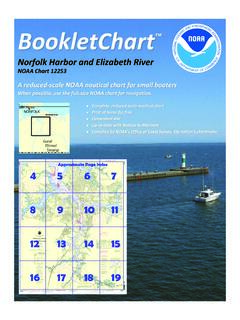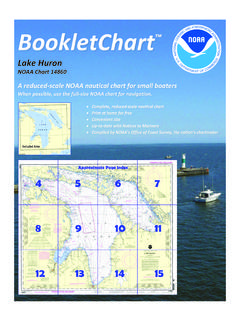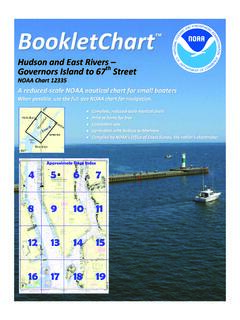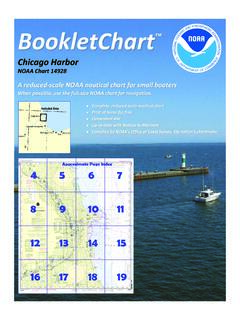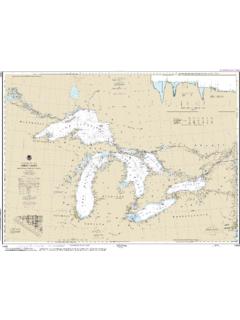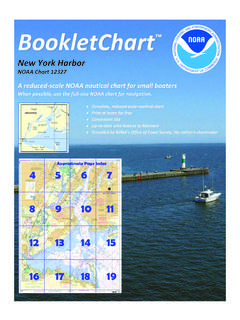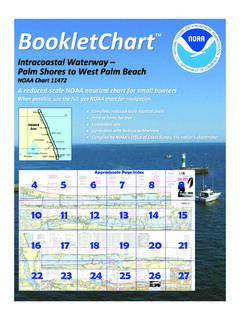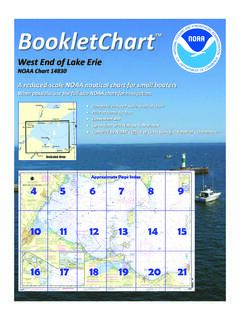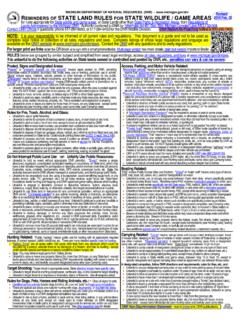Transcription of Lake Michigan - National Oceanic and Atmospheric ...
1 BookletChart lake Michigan NOAA Chart 14901 A reduced-scale NOAA nautical chart for small boaters When possible, use the full-size NOAA chart for navigation. Included Area 2 Published by the National Oceanic and Atmospheric Administration National Ocean Service Office of Coast Survey 888-990-NOAA What are Nautical Charts? Nautical charts are a fundamental tool of marine navigation. They show water depths, obstructions, buoys, other aids to navigation, and much more. The information is shown in a way that promotes safe and efficient navigation. Chart carriage is mandatory on the commercial ships that carry America s commerce. They are also used on every Navy and Coast Guard ship, fishing and passenger vessels, and are widely carried by recreational boaters.
2 What is a BookletChart ? This BookletChart is made to help recreational boaters locate themselves on the water. It has been reduced in scale for convenience, but otherwise contains all the information of the full-scale nautical chart. The bar scales have also been reduced, and are accurate when used to measure distances in this BookletChart. See the Note at the bottom of page 5 for the reduction in scale applied to this chart. Whenever possible, use the official, full scale NOAA nautical chart for navigation. Nautical chart sales agents are listed on the Internet at This BookletChart does NOT fulfill chart carriage requirements for regulated commercial vessels under Titles 33 and 44 of the Code of Federal Regulations.
3 Notice to Mariners Correction Status This BookletChart has been updated for chart corrections published in the Coast Guard Local Notice to Mariners, the National Geospatial Intelligence Agency Weekly Notice to Mariners, and, where applicable, the Canadian Coast Guard Notice to Mariners. Additional chart corrections have been made by NOAA in advance of their publication in a Notice to Mariners. The last Notices to Mariners applied to this chart are listed in the Note at the bottom of page 7. Coast Pilot excerpts are not being corrected. For latest Coast Pilot excerpt visit the Office of Coast Survey website at (Selected Excerpts from Coast Pilot) lake Michigan is the third largest of the Great Lakes and is the only one entirely within the United States.
4 The only natural outlet of the lake is at the north end through the Straits of Mackinac. At the south end of the lake , the Illinois Waterway provides a connection to the Mississippi River and the Gulf of Mexico. The north part of the lake has many islands and is indented by several bays; Green Bay and Grand Traverse Bay are the largest. The shores in the south part of the lake are regular, and it has been necessary to construct artificial harbors. The shores in the north part of the lake are sparsely populated, while those in the south part are near the heart of the urban industrial area of the Midwest. Fluctuations of water level. The normal elevation of the lake surface varies irregularly from year to year. During the course of each year, the surface is subject to a consistent seasonal rise and fall, the lowest stages prevailing during the winter and the highest during the summer.
5 Weather, lake Michigan . Gales are most likely from September through April, particularly in the fall. During this season gales blow 3 to 7 percent of the time; speeds of 28 knots or more occur from 12 to 20 percent of the time. Strong winds often blow out of the W and northwest, making east shore harbor entrances dangerous. The strongest measured over-the- lake wind was out of the west-southwest at 58 knots. Spring winds can blow strong, with winds of 28 knots or more about 4 to 8 percent of the time. They do slacken from their winter fierceness, with southerlies and southwesterlies becoming more frequent and northerlies less so as summer approaches. Strong winds are infrequent in summer and mostly associated with thunderstorms.
6 S and southwest winds prevail particularly in the N; southeasterlies are also common in the S. Northerlies are a secondary wind. Pilotage. The waters of lake Michigan are Great Lakes undesignated waters; registered vessels of the United States and foreign vessels are required to have in their service a United States or Canadian registered pilot or other officer qualified for Great Lakes undesignated waters. Registered pilots for lake Michigan are supplied by Western Great Lakes Pilots Association (See Appendix A for addresses.) Pilot exchange points are off Port Huron at the head of St. Clair River in about 43 05'30"N., 82 24'42"W. and at De Tour, MI, at the entrance to St. Marys River. Three pilot boats are at Port Huron; HURON BELLE has an international orange hull with an aluminum cabin, and HURON MAID and HURON LADY each have an international orange hull with a white cabin.
7 The pilot boat at De Tour, LINDA JEAN, has a green hull and a white cabin. (See Pilotage, chapter 3, and 46 CFR 401, chapter 2.) Principal ports. Most of the harbors on the east side of lake Michigan are within the mouths of small rivers or in small lakes connected to lake Michigan by an entrance channel. Parallel piers have been constructed at the mouths of these harbors to aid in carrying the bar into deeper water and to lessen the need for dredging in the harbor entrance. In addition, several harbors along this shore have been provided with stilling basins formed by breakwaters that converge to an entrance opening in deep water beyond the parallel piers. These basins dissipate the force of storm generated waves to prevent them from being conducted through the confined channels between the piers and into the harbors.
8 The harbors on the west side of the lake are generally at the mouths of small rivers, the only large streams being the Fox and Menominee Rivers which empty into Green Bay. The entrances to the harbors are generally protected by parallel piers, and some have been provided with stilling basins. Some harbor entrances are protected by detached breakwaters. Outer harbors enclosed by breakwaters have been constructed at Calumet Harbor and Milwaukee. Entirely artificial harbors, with basins enclosed by piers and breakwaters, are at Burns International Harbor, Gary, Buffington, Indiana Harbor, Great Lakes, Waukegan, Port Washington, and Port Inland. The most important harbors in lake Michigan are Muskegon, Calumet, Chicago, Milwaukee, Kenosha, and Green Bay.
9 Drydocking facilities for deep-draft vessels are at Sturgeon Bay. Coast Guard Rescue Coordination Center 24 hour Regional Contact for Emergencies RCC Cleveland Commander 9th CG District (216) 902-6117 Cleveland, OH G NOAA s navigation managers serve as ambassadors to the maritime community. They help identify navigational challenges facing professional and recreational mariners, and provide NOAA resources and information for safe navigation. For additional information, please visit To make suggestions or ask questions online, go to To report a chart discrepancy, please use Lateral System As Seen Entering From Seaward on navigable waters except Western Rivers PORT SIDE ODD NUMBERED AIDS GREEN LIGHT ONLY FLASHING (2) PREFERRED CHANNEL NO NUMBERS MAY BE LETTERED PREFERRED CHANNEL TO STARBOARD TOPMOST BAND GREEN PREFERRED CHANNEL NO NUMBERS MAY BE LETTERED PREFERRED CHANNEL TO PORT TOPMOST BAND RED STARBOARD SIDE EVEN NUMBERED AIDS RED LIGHT ONLY FLASHING (2) FLASHING FLASHING OCCULTING GREEN LIGHT ONLY RED LIGHT ONLY OCCULTING QUICK FLASHING QUICK FLASHING ISO COMPOSITE GROUP FLASHING (2+1) COMPOSITE GROUP FLASHING (2+1)
10 ISO "1" Fl G 6s G "9" Fl G 4s GR "A" Fl (2+1) G 6s RG "B" Fl (2+1) R 6s "2" Fl R 6s 8 R "8" Fl R 4s LIGHT G C "1" LIGHTED BUOY G "5" GR "U" GR C "S" RG N "C" RG "G" LIGHT 6 R N "6" LIGHTED BUOY R "2" CAN DAYBEACON CAN NUN NUN DAYBEACON For more information on aids to navigation, including those on Western Rivers, please consult the latest USCG Light List for your area. These volumes are available online at Navigation Managers Area of Responsibility Northeast Lt. Meghan McGovern Northwest and Pacific Islands Crescent Moegling Great Lakes Region Tom Loeper Chesapeake and Delaware Bay Steve Soherr California Jeff Ferguson Mid-Atlantic Lt. Ryan Wartick Alaska Lt.
